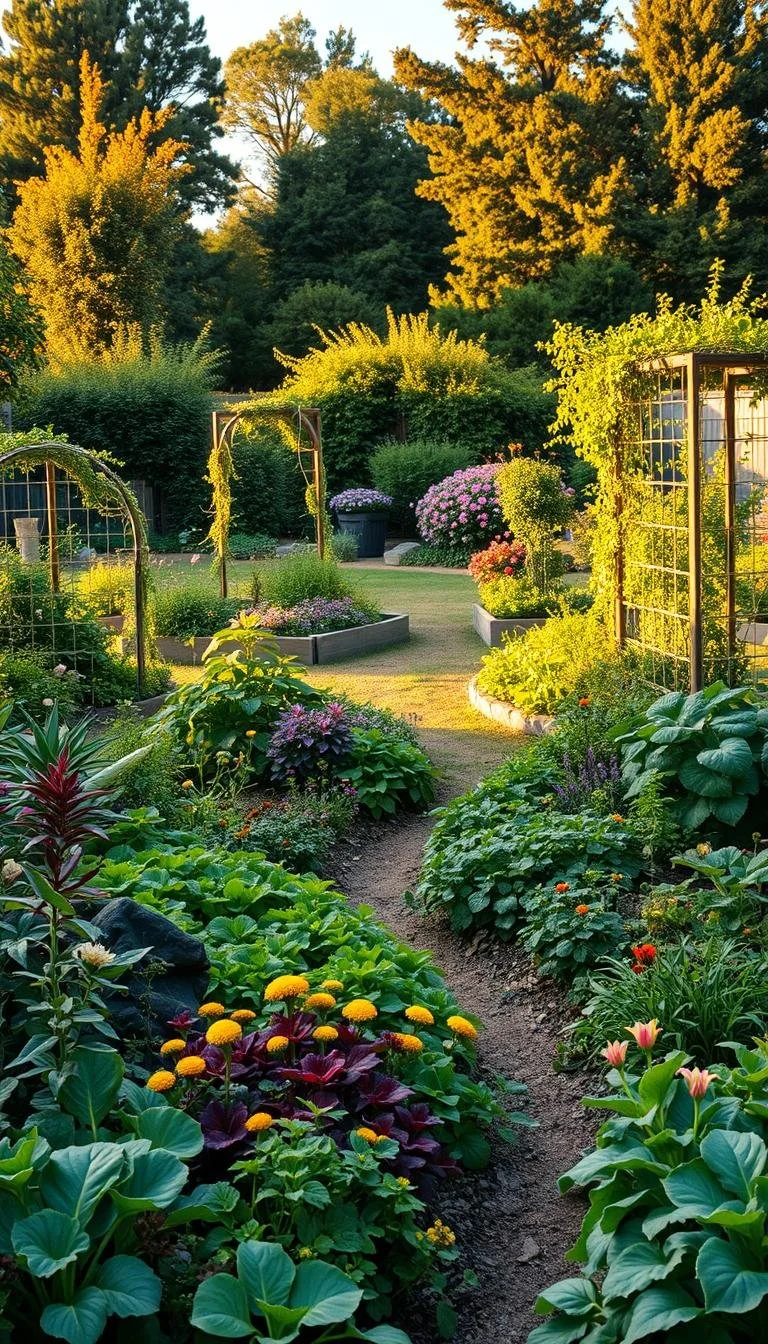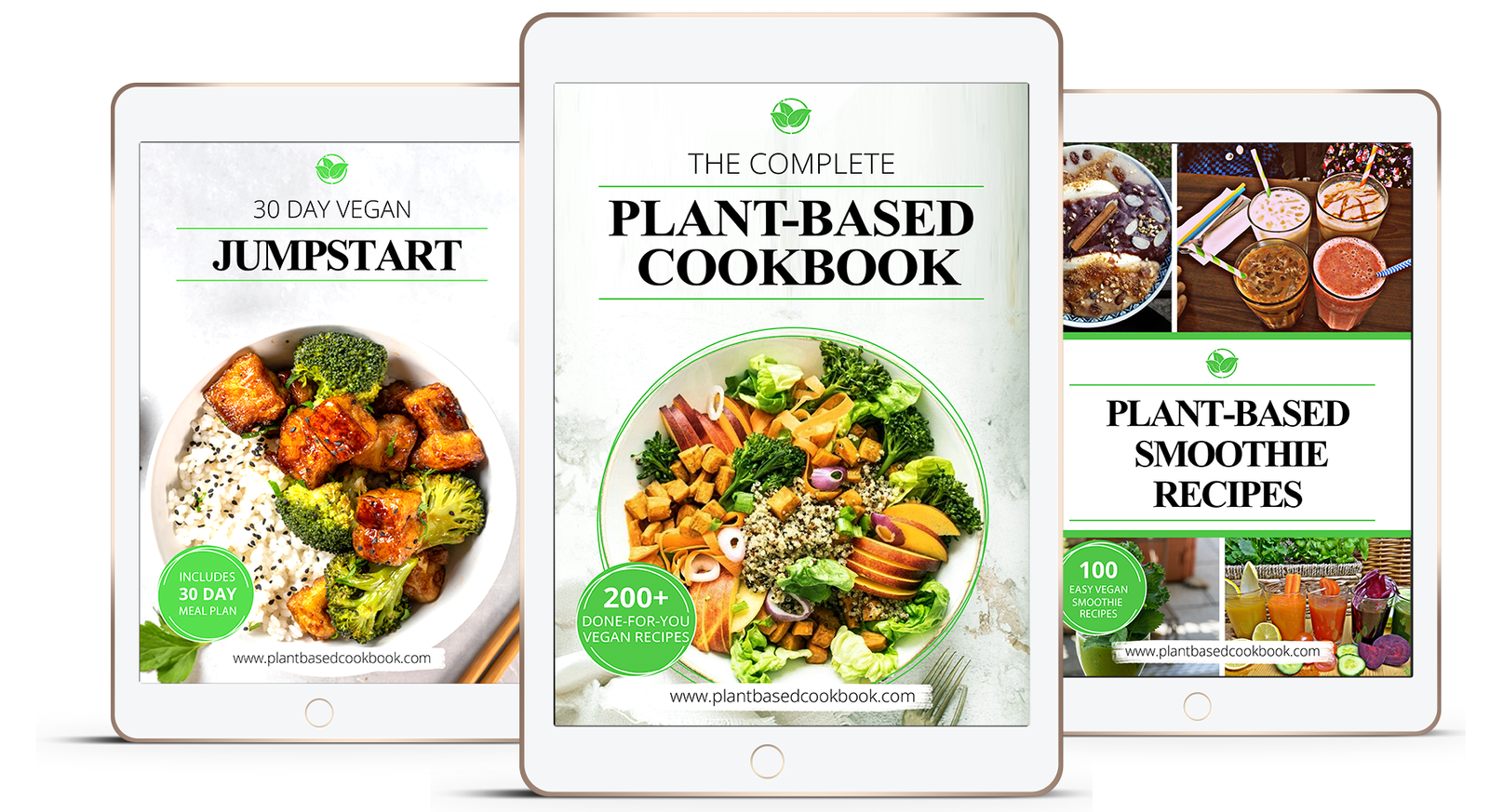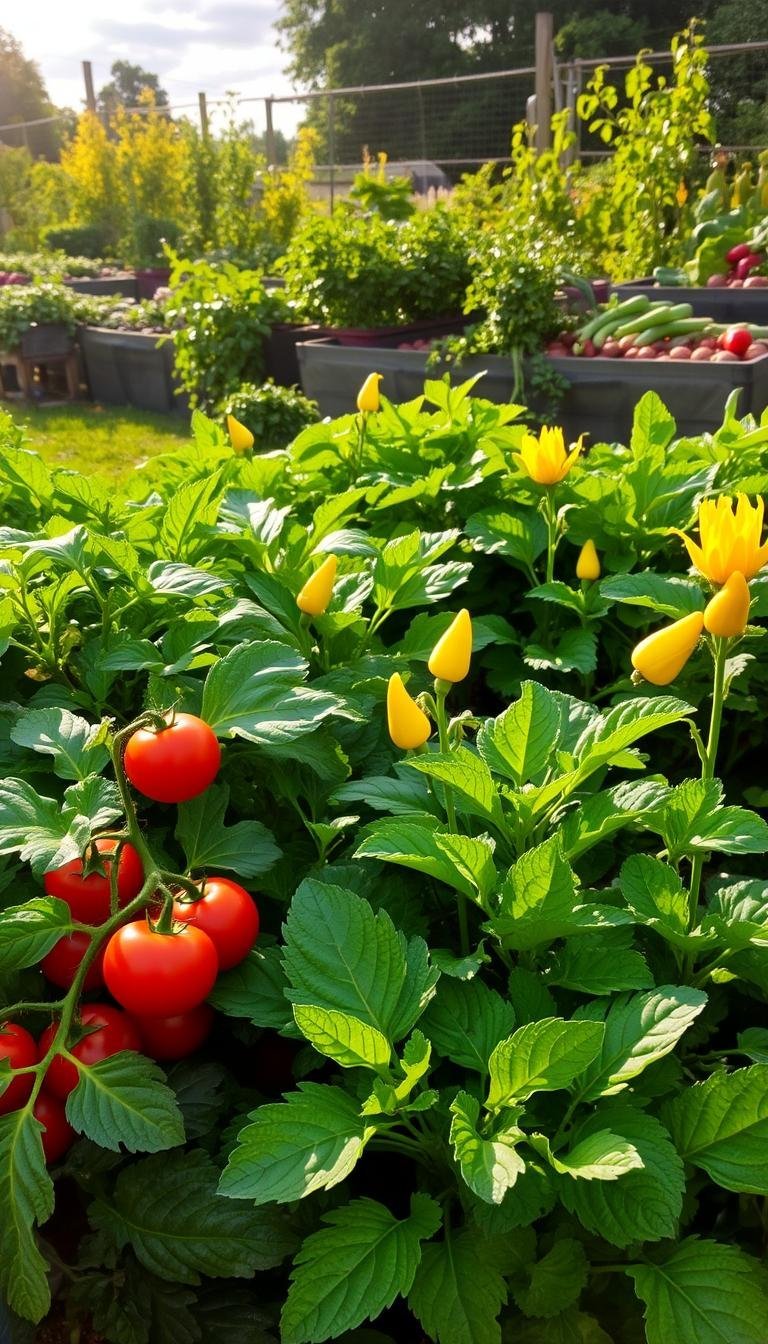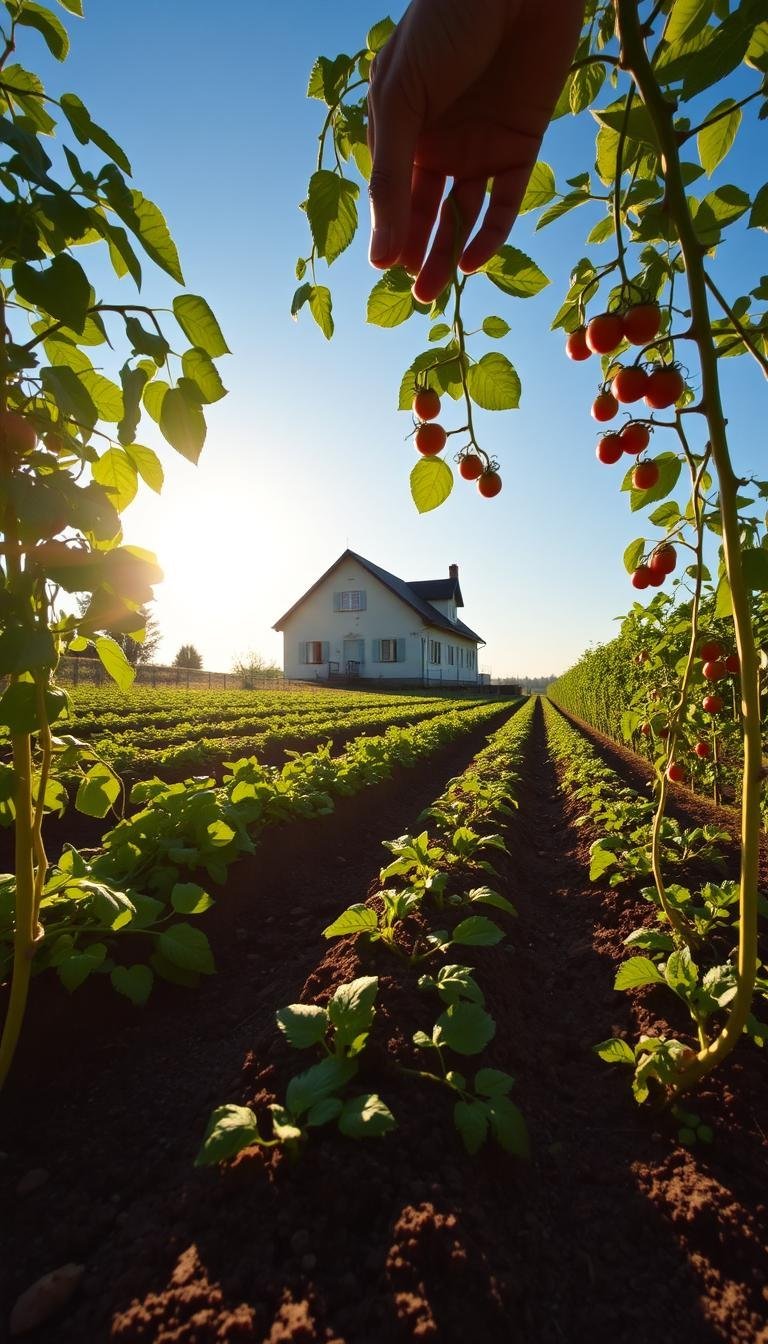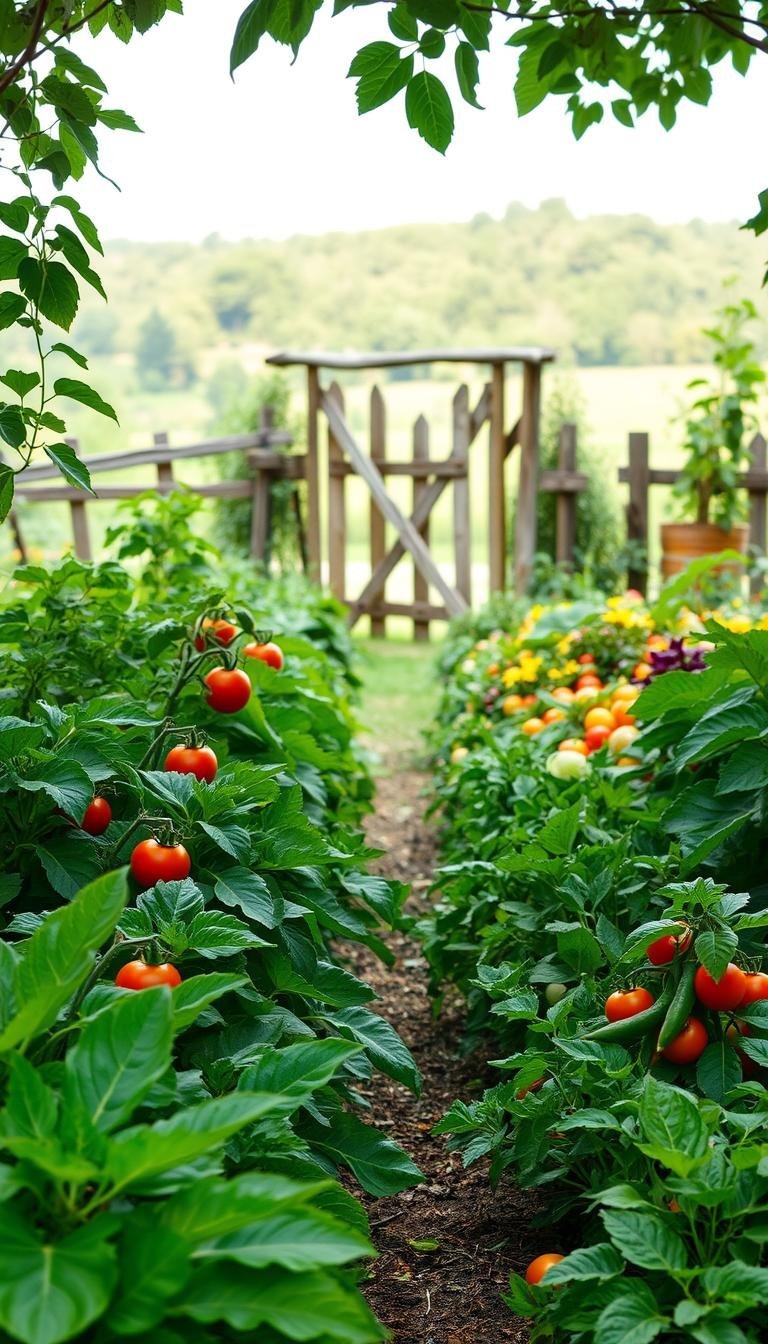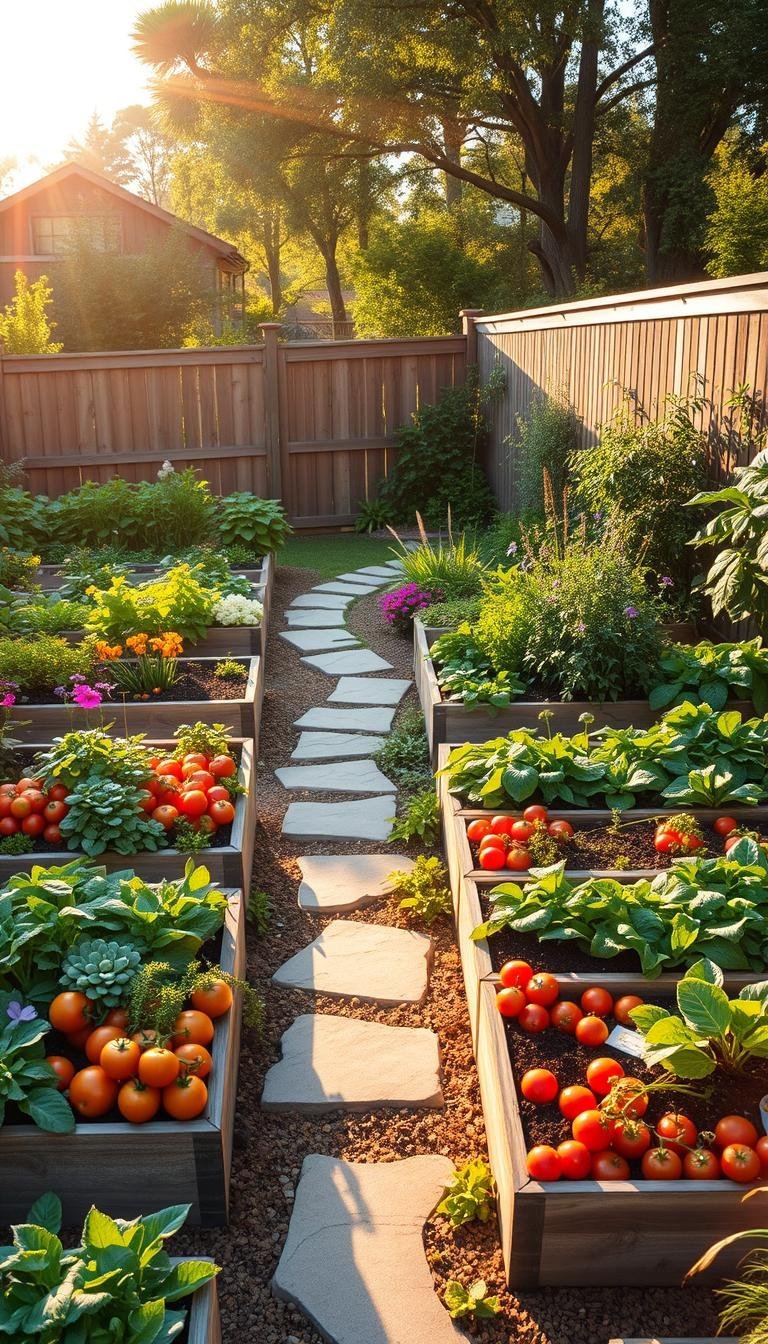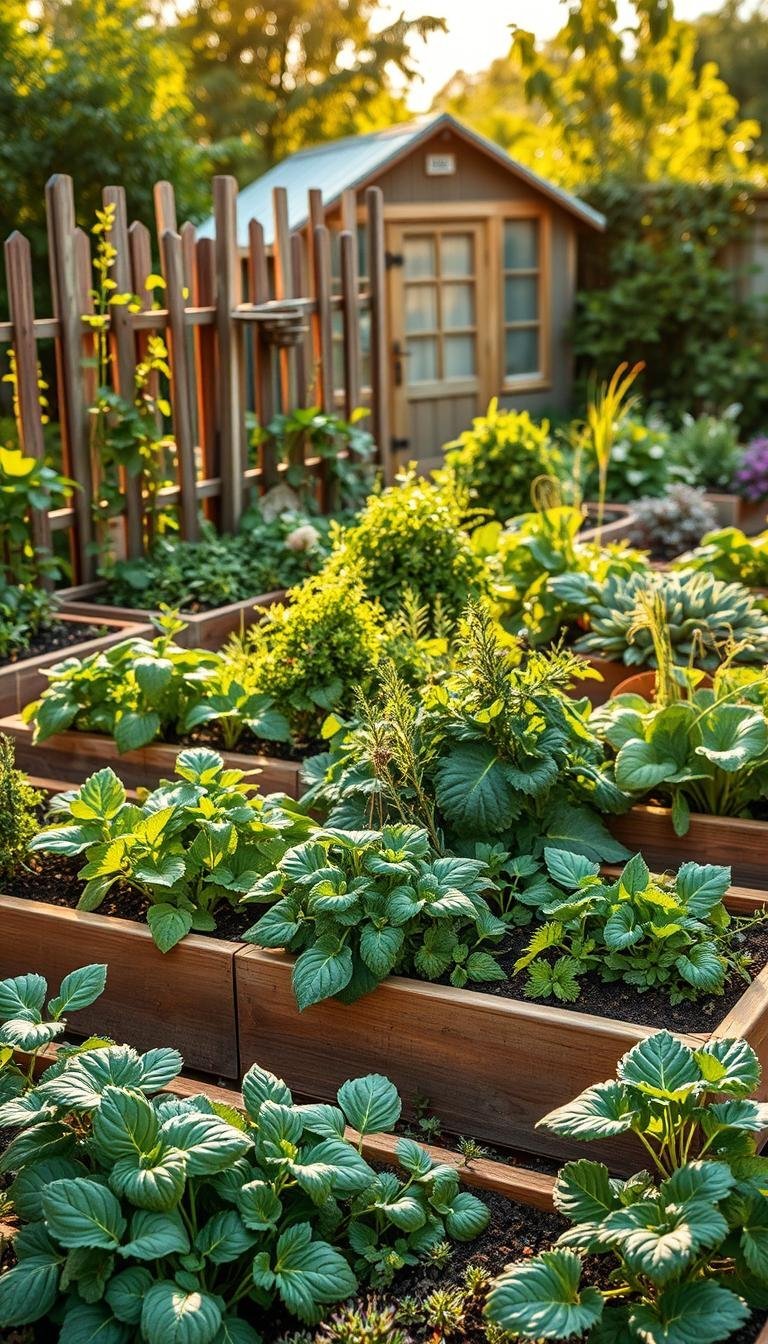(Hey! Some links in this post may be affiliate links — meaning I may earn a small commission if you buy through them, at no extra cost to you. As an Amazon Associate, I earn from qualifying purchases. I only share products I genuinely love and think you’ll find useful too. Read the full disclosure here).
Creating a food garden at home is easier than you think. With the right Food Garden Ideas, even small spaces can become productive edible landscapes. Whether you’re starting with a backyard plot or a balcony container, this guide shows how to grow fresh herbs, vegetables, and fruits sustainably.
Edible Landscape Design blends beauty and function, turning ordinary yards into spaces that feed both body and soul. Learn how to plan layouts that maximize yield while making your home look great. Discover techniques for any climate or space, from sun-loving tomatoes to shade-tolerant greens.
🌿 Want to Take Your Garden to the Next Level?
If you're serious about growing your own food and becoming more self-reliant, The Self-Sufficient Backyard is a must-read...
🌱 Learn MoreThis guide covers tools, soil care, and planting strategies so you can enjoy fresh produce year-round. Explore creative solutions for pests, watering, and preserving harvests. Start transforming your outdoor space into a vibrant, nourishing Food Garden Ideas hub today!
Contents
- 1 Understanding the Basics of Food Gardening
- 2 Selecting the Right Plants for Your Garden
- 3 Container Gardening for Limited Spaces
- 4 Raised Bed Gardening Essentials
- 5 Vertical Gardening Techniques
- 6 Incorporating Pollinators into Your Food Garden
- 7 Sustainable Gardening Practices
- 8 Maintaining Your Food Garden
- 9 Ideas for Seasonal Food Gardening
- 10 Creative Gardening Layouts
- 11 Harvesting and Using Your Garden Produce
- 12 Community Involvement and Gardening
Understanding the Basics of Food Gardening
Starting a food garden is a great way to get fresh produce and enjoy the outdoors. Whether you’re new or want to improve your Food Garden Ideas, planning your Vegetable Garden is key. Let’s cover the basics to grow a successful garden.
Importance of Homegrown Produce
Eating veggies from your garden means you get more nutrients and taste. Research shows that fresh produce has more vitamins than store-bought. It also saves money and reduces waste. The USDA says, “Home gardens help families save money and promote sustainable living.”
Choosing the Right Location
Location is important! Here are some tips for Vegetable Garden Planning:
- Choose a sunny spot—most veggies need 6+ hours of sunlight.
- Put your garden near water for easy watering.
- Use fences or shrubs to protect plants from strong winds.
Soil Preparation for Healthy Growth
Soil is the base of a healthy garden. Start by:
- Test your soil pH with a kit from a garden store.
- Add compost or organic matter to improve soil.
- Use lime for acidic soil or sulfur for alkaline soil.
Good soil means strong roots, bigger plants, and fewer pests. Get it right, and your plants will thrive!
Selecting the Right Plants for Your Garden
Starting a Vegetable Garden Planning means picking the right plants. Whether it’s a Kitchen Garden Layout or a big plot, choose plants that fit your climate and space. Let’s find out how to pick the best vegetables, herbs, and flowers for a great garden.
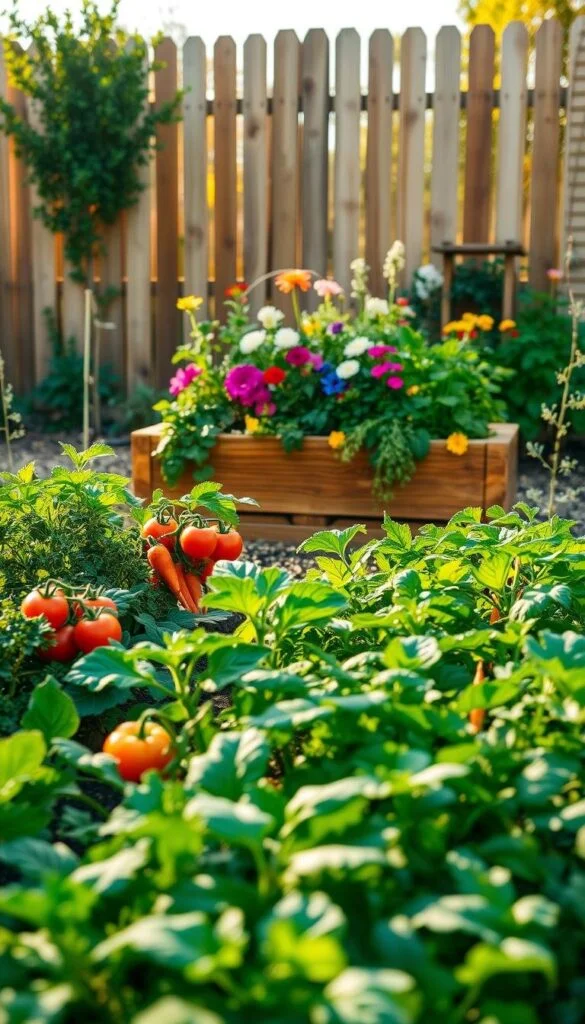
Vegetables vs. Herbs: What to Grow
Vegetables like tomatoes or peppers need lots of sun and space. Herbs like basil or thyme do well in small spots and taste great in food. Think about your Kitchen Garden Layout—small herbs are perfect for tight spaces, while veggies need more room.
Seasonal Planting Guides
- Spring: Plant lettuce, peas, and spinach.
- Summer: Grow beans, cucumbers, and zucchini.
- Fall: Try kale, Brussels sprouts, and carrots.
- Winter: Overwinter garlic and onions in mild climates.
Companion Planting Explained
Planting the right pairs can help your garden grow. Tomatoes and basil keep pests away. Carrots and onions taste better together. But, avoid planting beans and onions, as they can slow each other down.
Flower and Herb Combinations
Marigolds keep nematodes away when near herbs like rosemary. Nasturtiums attract pollinators and look good with mint or chives. These pairs help control pests and add beauty to your garden.
Container Gardening for Limited Spaces
Even in small urban settings, growing fresh produce is achievable with container gardening vegetables. This method transforms patios, balconies, and windowsills into productive spaces. It uses urban farming techniques tailored to tight layouts.
- Self-watering pots that retain moisture
- Hanging baskets for leafy greens or strawberries
- Upcycled items like buckets or wooden crates
- Stackable towers for vertical container gardening vegetables
Soil choice matters. Use premium mixes like Dr. Earth Organic Premium Potting Soil. It blends peat, perlite, and compost for drainage and nutrients. Avoid garden soil—it compacts easily in small spaces.
Which Plants Thrive?
Compact varieties excel in containers. Try:
- Cherry tomatoes (e.g., ‘Tumbling Tom’)
- Lettuce and mesclun mixes
- Dwarf peppers and bush beans
- Herb combos like basil, thyme, and rosemary
Experiment with tiered setups. Place tall plants like kale in the back and trailing herbs like cilantro in front. Rotate containers weekly to ensure even sunlight exposure. With these tips, even city dwellers can enjoy homegrown harvests.
Raised Bed Gardening Essentials
Raised Bed Gardening changes vegetable garden planning for the better. It offers solutions for home gardeners. These elevated plots help with soil drainage, extend growing seasons, and ease back strain. Let’s dive into how to build and keep these spaces productive.
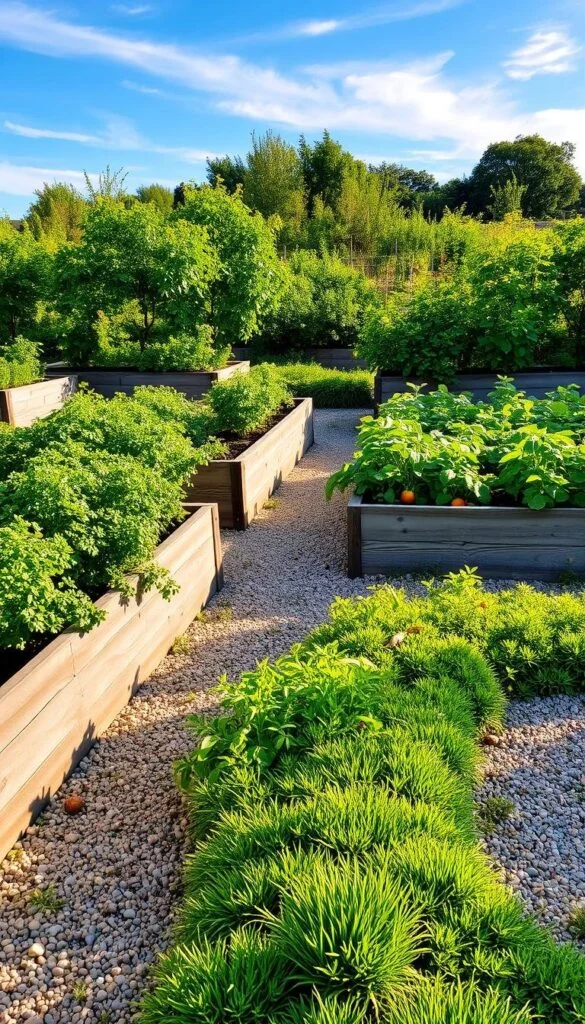
Benefits of Raised Beds
- Drainage: Avoid waterlogging with elevated soil layers.
- Longer Seasons: Warmer soil starts spring planting earlier.
- Ease of Access: Waist-high beds cut kneeling time by 70%.
Designing Your Raised Garden Bed
Choosing the right materials is key. Cedar wood fights rot, while composite boards resist warping. Opt for 3-4 foot widths for easy access. Creative designs include L-shapes for small yards or tiered beds on slopes.
For Vegetable Garden Planning, group plants by water needs in separate beds. This makes care easier.
Soil Selection and Fertilization
For the best soil, mix 60% garden soil, 30% compost, and 10% perlite. Use organic pellets for fertilizing at planting time. Add a 2-inch compost layer in fall to refresh the soil. Stay away from synthetic additives to keep the soil pH balanced.
Vertical Gardening Techniques
Vertical gardening turns blank walls and fences into green spaces. These Urban Farming Techniques save space and increase yields. They’re great for small yards or urban areas.
Whether it’s a balcony or a backyard fence, vertical gardens make unused areas lively. They become part of your Edible Landscape Design.
Plant Selection for Vertical Gardens
Look for plants that climb, trail, or grow small. Vining crops like peas, beans, and cucumbers do well on trellises. Strawberries and leafy greens are perfect for hanging planters.
Herbs like mint or thyme cascade from elevated shelves. But, avoid heavy fruits like watermelons unless you have strong supports.
DIY Vertical Gardening Structures
- Trellises: Put A-frame or lattice panels on fences for peas and tomatoes.
- Pallet Gardens: Drill holes in old wooden pallets for herbs or veggies with shallow roots.
- Hanging Systems: Hang containers from sturdy eaves or pergolas using macramé hangers or S-hooks.
- Living Walls: Build pockets with soil for lettuce or strawberries using vertical garden kits.
Maintenance Tips for Vertical Gardens
Water vertical gardens every 2–3 days, more often in pots. Use soaker hoses or drip irrigation to water all levels. Prune stems to keep them growing up.
Check shallow containers weekly to avoid root overcrowding. Rotate plants if one side gets more sun.
Incorporating Pollinators into Your Food Garden
Pollinators are nature’s helpers in every garden. Bees, butterflies, and other insects boost yields and ensure healthy crops. Sustainable Food Growing thrives when these creatures have spaces to feed and nest. Simple Organic Gardening Tips can turn your garden into a pollinator hotspot.
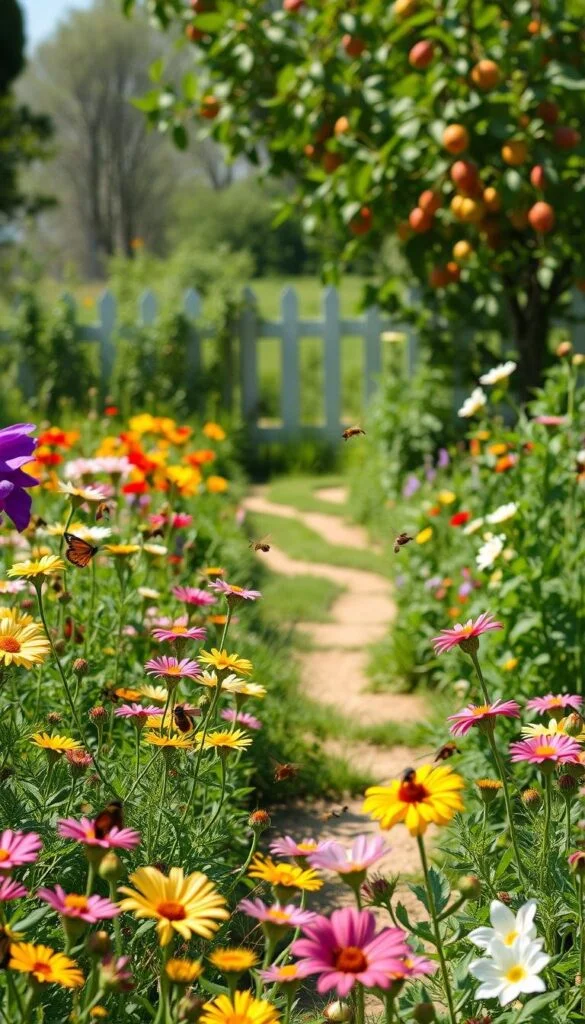
Plant a mix of flowers and vegetables to keep blooms active all season. Include these top picks:
- Native wildflowers like aster and sunflowers
- Bee balm and lavender for nectar
- Milkweed for monarch butterflies
- Zucchini and squash blossoms
Water sources are vital. Place shallow dishes filled with pebbles so insects can drink safely. Leave patches of bare soil for ground-nesting bees. Organic Gardening Tips advise avoiding pesticides—try ladybugs or neem oil for pest control instead.
Create shelter by stacking deadwood or installing bee hotels. Letting leaf litter stay over winter gives insects safe overwintering spots. These steps make your garden a year-round pollinator haven. Sustainable Food Growing becomes easier when pollinators do the work of pollination, leading to bigger harvests naturally.
Sustainable Gardening Practices
Start making your garden eco-friendly by choosing earth-friendly options. Sustainable Food Growing and Organic Gardening Tips help keep plants healthy without harming nature. These methods save resources and create a thriving ecosystem.
Organic Gardening Basics
Grow without chemicals by using natural solutions. Organic Gardening Tips include mixing neem oil to fight pests or planting marigolds to repel aphids. Use homemade remedies like garlic spray for fungus. Skip synthetic pesticides to keep soil and water clean.
Composting for Nutrient-Rich Soil
Recycle kitchen scraps into soil food. Compost fruit peels, coffee grounds, and yard waste in bins or worm setups. This turns waste into fertilizer, cutting landfill contributions. Add compost to soil yearly to boost plant strength.
Water Conservation Techniques
Use water wisely with smart strategies. Mulch around plants to hold moisture. Drip irrigation delivers water straight to roots. Collect rain in barrels during storms. Choose drought-tolerant plants like rosemary or sage to reduce watering needs.
Maintaining Your Food Garden
Maintaining your garden is not just hard work—it’s smart work. Small, regular efforts keep plants thriving and prevent problems before they start. A well-tended garden rewards you with bountiful harvests and less frustration down the line.
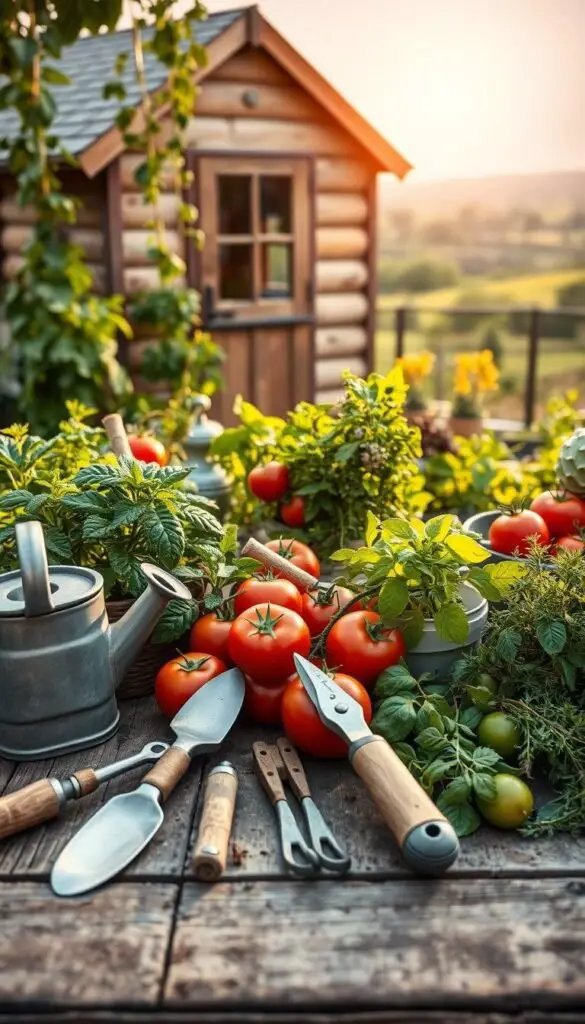
Start with the right tools. Invest in a sturdy trowel, sharp pruners (like Fiskars bypass shears), and a cultivating fork. Budget options like Hori Hori knives work well for small gardens. A watering can and soaker hose ensure efficient irrigation without wasting water.
“A clean garden stays healthy.”
- Weeding: Remove weeds weekly before they seed.
- Tool care: Clean blades and store tools dry to extend their lifespan.
For pest control, follow Organic Gardening Tips. Spot-check plants daily. Handpick caterpillars or use neem oil sprays for soft-bodied pests. Row covers protect young plants without chemicals. Early intervention stops infestations before they spread.
- Water deeply but less frequently to encourage deep roots.
- Avoid wetting leaves—drip systems reduce disease risk.
- Mulch soil surfaces to retain moisture and suppress weeds.
Adjust strategies based on your Kitchen Garden Layout. Group plants with similar water needs together. Taller plants cast shade—use this to protect heat-sensitive crops. Regularly rotate crops to avoid soil-borne diseases.
Weekly inspections catch issues early. Keep a journal to track plant progress and seasonal patterns. With these steps, your garden stays productive without daily labor. Small routines turn into big results over time.
Ideas for Seasonal Food Gardening
Make your garden a year-round food source by adapting to each season. Smart vegetable garden planning makes sure plants grow in sync with nature. This approach leads to more food and fun.
Spring Planting Guide
Start food garden ideas early with indoor seed starts. Use peat pots for tomatoes and peppers under grow lights 6–8 weeks before the last frost. Move seedlings outdoors in shaded spots for 2–3 hours a day.
Plant cool-season crops like peas and lettuce when soil hits 50°F. Keep a calendar for frost dates and planting times.
Summer Harvesting Tips
- Harvest beans daily to encourage new blooms
- Pick zucchinis when small to prevent bitterness
- Water deeply in early morning to reduce evaporation
Fall Crop Suggestions
Cool weather offers a second chance for growth. Sow beets, kale, and arugula in late July for autumn harvests. Use floating row covers to protect plants from frost.
Root vegetables like carrots store well in the ground if mulched thickly.
Preparing for Winter
Mulch perennial herbs with straw to shield roots. Tuck compost into empty beds to nourish soil over winter. Mark spots for spring planting with labeled stakes.
Cold frames extend harvests of spinach and lettuce into colder months.
Creative Gardening Layouts
Your Kitchen Garden Layout can be both beautiful and useful. It turns your area into an Edible Landscape Design that’s inspiring. With careful planning, it’s easy to get to and fun to care for.
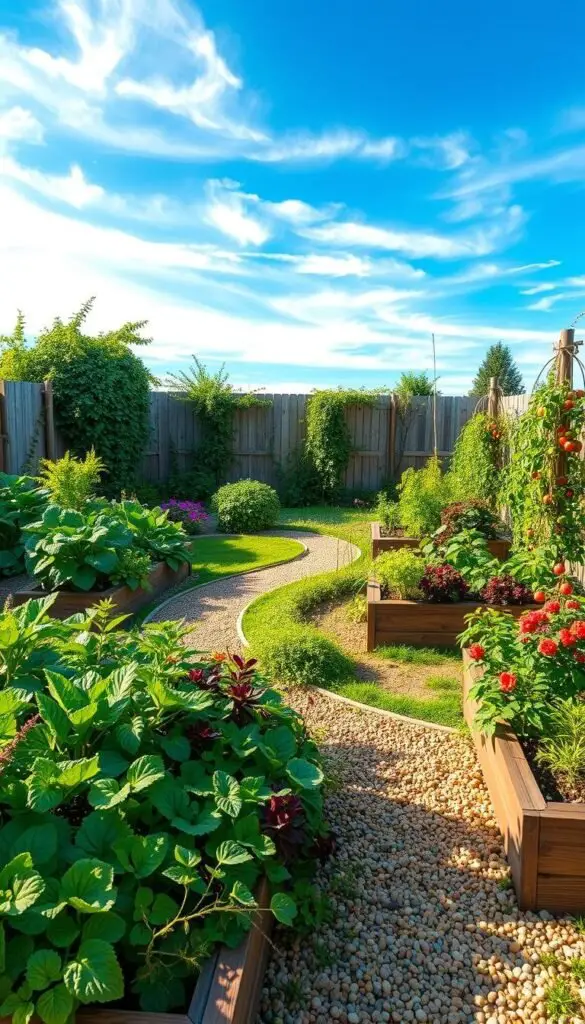
Designing Paths for Accessibility
Paths help keep the soil healthy by avoiding compaction. Choose materials like gravel, mulch, or stepping stones. Paths should be 2-3 feet wide for carrying tools.
Curved paths are more interesting and guide visitors around plants.
Incorporating Aesthetics with Functionality
An Edible Landscape Design mixes looks with usefulness. Plant colorful lettuces along borders or grow purple basil next to peppers. Use vertical elements like trellises for beans or cucumbers.
Edging with stones or brick keeps things neat without clutter.
Themed Garden Spaces
Create areas based on themes:
- Pizza garden: tomatoes, basil, peppers, and oregano.
- Cocktail garden: mint, lemon verbena, and edible flowers.
- Herb spiral: arrange herbs by sun and water needs in a circular bed.
These designs make picking produce easier and add beauty.
Harvesting and Using Your Garden Produce
Once your plants are thriving, it’s time to learn when and how to pick them. This ensures your crops taste their best and keep growing. Whether you have a small Food Garden Ideas setup or a bigger Kitchen Garden Layout, these tips will help you enjoy your hard work.
Best Harvesting Practices
- Snip herbs just before midday for maximum oil content.
- Pick beans daily to encourage new pods.
- Check squash daily—mature ones feel heavy and have a hollow sound when tapped.
Recipes to Try with Fresh Produce
Bring out the flavors of your garden with these simple dishes:
- Creamy cucumber soup blended with fresh dill.
- Roasted root veggies tossed with thyme from your plot.
- Tomato bruschetta with basil from your herb patch.
Preserving and Storing
Keep your harvest going with these methods:
Freeze berries and peas in labeled bags for winter use.
- Canning jars for jams using USDA-recommended techniques.
- Dehydrate herbs on a rack for winter seasoning.
- Bury carrots in a sand-filled bin for cellar storage.
“Sharing extra zucchini with neighbors strengthens community ties.” – Urban Harvest Collective
Join local food drives to share your bounty. This way, you can make a difference in your community.
Community Involvement and Gardening
Your food garden can connect you with neighbors and boost local food systems. By working together, you make a bigger difference in Sustainable Food Growing and Urban Farming Techniques.
Joining Local Gardening Groups
Look for community gardens and plant swaps on Meetup or your city’s parks website. The National Garden Association hosts events for exchanging seeds and tips. Working with others improves your skills and shares resources.
Sharing Your Harvest
Give extra produce to food banks like Feeding America. Some cities have “gleaning” programs for collecting extra crops. Even a little help can cut down on waste and support your neighbors.
Educational Programs and Workshops
Local extension offices, like those under the USDA, offer free Master Gardener courses. Workshops on Urban Farming Techniques are at places like the New York Botanical Garden. Sharing your knowledge online or in your neighborhood benefits everyone.

